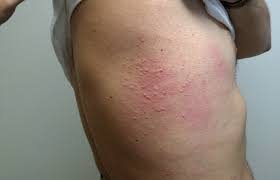 Alpha-gal allergy, also known as meat allergy or mammalian meat allergy (MMA).
Alpha-gal allergy, also known as meat allergy or mammalian meat allergy (MMA).
It is a reaction to galactose-alpha-1,3-galactose (alpha-gal).
The body is overloaded with immunoglobulin E (IgE) antibodies on contact with the carbohydrate.
Anti-gal is a human natural antibody that interacts specifically with the mammalian carbohydrate structure gal alpha 1-3Gal beta 1-4GlcNAc-R.
The alpha-gal molecule is found in all mammals except apes, humans, and Old World monkeys.
Caused by bites from certain species of ticks-predominantly the Lone Star tick.
In the US, the allergy most often occurs in the central and southern regions, which corresponds to the distribution of the lone star tick.
Alpha-gal syndrome, prevalence correlates with regional endemicity of the lone star stick with this food allergy emerging as a leading cause of anaphylaxis in adults.
Bites from certain ticks, can transfer this carbohydrate to a victim, and is implicated in the development of this delayed allergic response to consumption of mammalian meat products.
The seroprevalence estimates of Alpha-gal sensitization in the southeast US ranges from 20 to 31%.
Poultry, fish, and in rare cases for some people, lean meat such as venison does not trigger a reaction.
A typical allergic reaction to alpha-gal has a delayed onset, occurring 3–8 hours after the consumption of mammalian meat products.
The allergic response is an IgE-mediated allergy, including severe whole-body itching, hives, angioedema, respiratory distress, gastrointestinal upset, and possible anaphylaxis.
It is a food allergy that has the possibility of delayed anaphylaxis.
It is first known food-related allergy associated with a carbohydrate, rather than a protein.
Alpha-gal allergies result after a person has been bitten by the lone star tick in the United States.
When a tick feeds on another mammal, the Alpha-gal remains in his GI tract and then is injected into a person’s skin, which causes the immune system to release IgE antibodies to fight the foreign carbohydrate.
The specific component of tick saliva that causes the reaction is unknown.
There is a high rate of alpha-gal allergy in the Western and North Central parts of the United States.
Alpha-gal is present in the anticancer drug cetuximab.
Blood thinners derived from porcine intestine and replacement heart valves derived from porcine tissue may also contain alpha-gal.
It is possible that alpha-gal in pig’s tissue use for xenografts might contribute to organ rejection.
Pathogenesis: saliva from the lone star tick contains alpha-gal, and that saliva is injected into the blood stream, releasing IgE antibodies to fight this foreign sugar.
Subsequent intake of mammal meat with the same alpha-gal causes an allergic reaction.
In contrast to the rapid onset of symptoms in food protein allergy symptoms, symptoms from alpha-gal syndrome frequently appear two or more hours after ingesting mammalian meat.
The alpha-gal allergy may recede over time, if person is not bitten by another tick.
Recovery time can take 8 months to 5 years.
Densitizations is being investigated.
IgE antibody response to the mammalian oligosaccharide epitope, alpha-gal, is associated with both the immediate-onset anaphylaxis during first exposure to intravenous cetuximab and the delayed-onset anaphylaxis 3 to 6 hours after ingestion of mammalian food products, such as beef or pork.
Management of acute alpha gal syndrome allergic reactions and anaphylaxis mirrors the approach used to manage allergic reactions in food protein allergy, including prompt treatment of severe allergic reactions with epinephrine and use of antihistamines and corticosteroids as adjunctive treatments.
In patients with mild, chronic symptoms involving the gastrointestinal tract or skin, antihistamines or oral mast cell stabilizes may be used.
Patients with Alpha-gal syndrome should avoid oral medications and supplements of porcine and bovine origin, gelatin capsules, poor scene or bovine heart valves anticoagulation with porcine heparin.
Overtime, serum alpha gal specific IgE levels decline, especially if additional tick bites are avoided.
